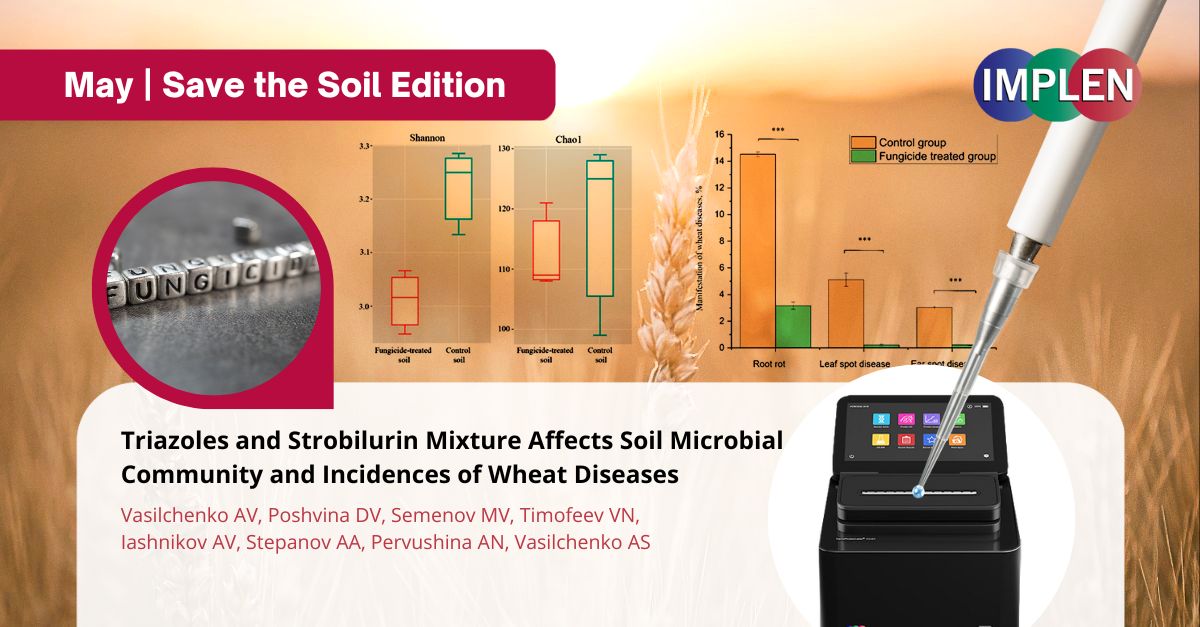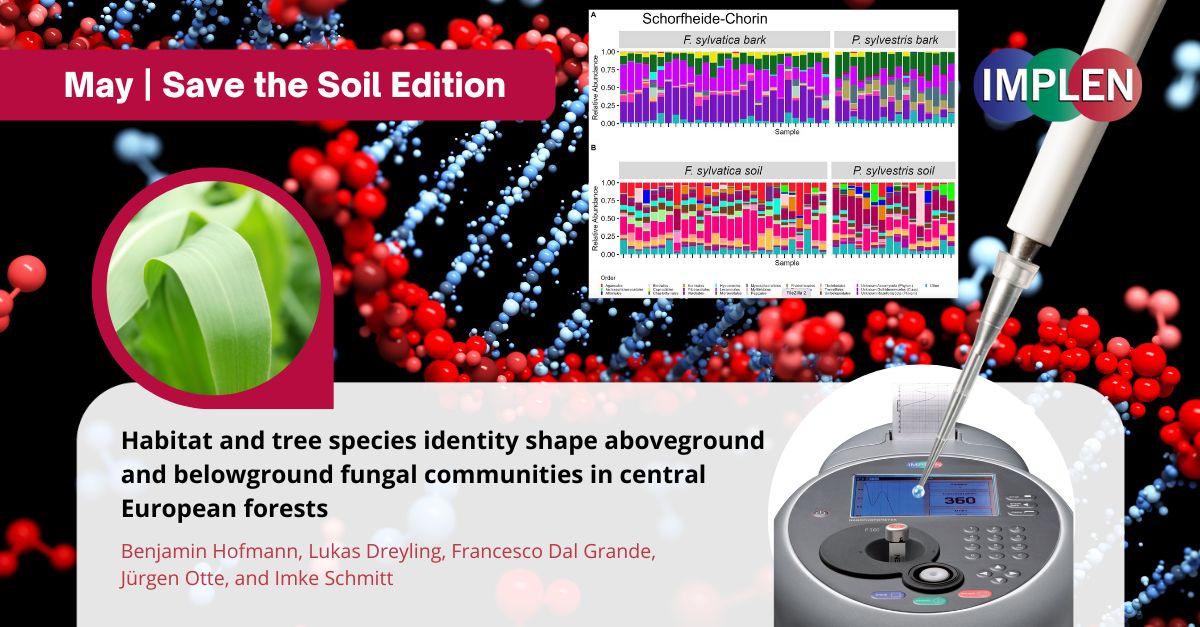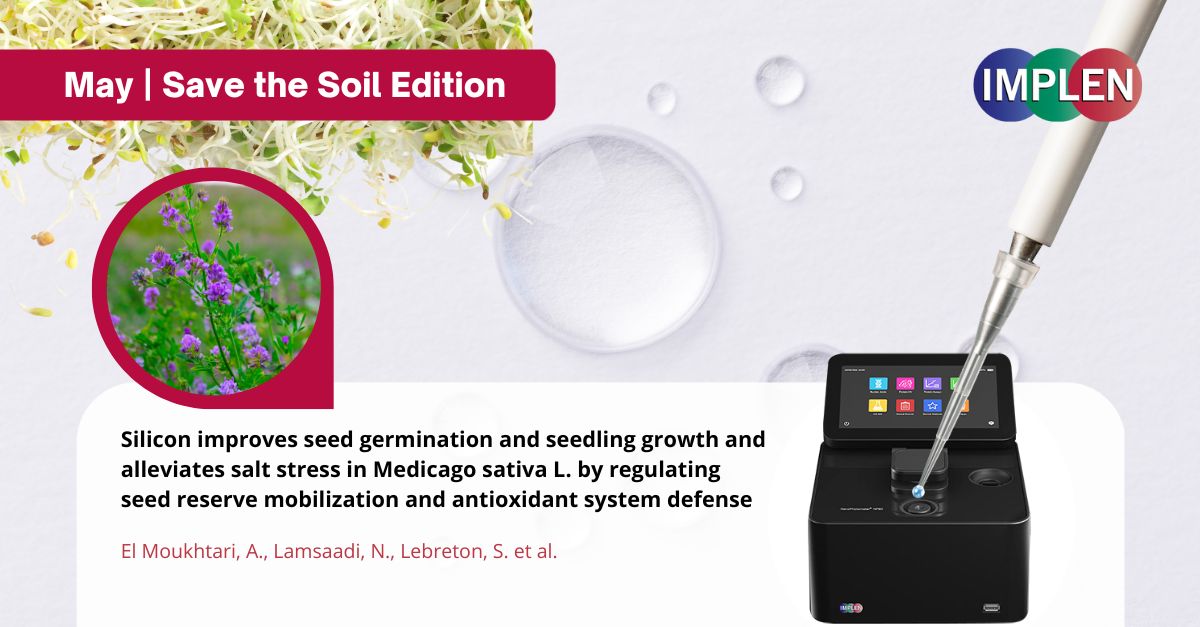Implen Journal Club | May Issue Spring Edition |
|
This issue of the Implen NanoPhotometer Journal Club: Save the Soil Edition, is highlighting the impact of pesticides on soil fungal and bacterial communities, as well as wheat diseases. Vasilchenko et. al. evaluated the potential adverse effects of a mixture of fungicides (difenoconazole, epoxiconazole, and kresoxim-methyl) on soil fungal and bacterial communities, as well as the manifestation of wheat diseases. The results showed that the fungicide mixture decreased the indices of both fungal and bacterial communities, while the relative abundances of certain bacterial taxa increased. This study also revealed a high potential for soil bacteria to degrade pollutants and for the soil fungal community to recover after the application of fungicides. The application of the fungicide mixture was found to be effective for pest control without posing a hazard to the soil ecosystem in the short term. Additionally, the study found that the combined fungicide mixture provided sufficient protection against phytopathogens in wheat while restructuring the soil microbiome. This suggests that combined fungicides based on strobilurins and triazoles provide a high level of plant protection with an acceptable impact on the soil system. Long-term studies are needed to assess the time frame for achieving functional and structural stability of the microbial community. The NanoPhotometer N120 was used in this study to assess the yield and quality of total soil DNA using the following absorbance ratios: A260 nm/230 nm (DNA/humic acid) and A260 nm/280 nm (DNA/protein). |
|
The second issue is highlighting a study that demonstrated Phytoremediation is an innovative and sustainable approach to remediate soil contaminated with petroleum hydrocarbons with the use of Enterobacter ludwigii ZCR5 strain. The results from this study published by Pacwa-Płociniczak et. al. in the journal of Applied Soil Ecology suggest that the strain could be a promising solution for the remediation of petroleum-contaminated soil. This is good news as contaminated soil is a major environmental concern and poses a risk to human health and ecosystems. Phytoremediation involves the use of plants to remove or degrade pollutants from soil. It is a cost-effective and eco-friendly approach that has gained popularity in recent years. In this process, the plants uptake the pollutants through their roots and break them down into harmless substances, or the pollutants can be trapped in the plant tissues. Enterobacter ludwigii ZCR5 strain has the potential to enhance phytoremediation because it can degrade multiple hydrocarbons, including benzene, toluene, and xylene. Furthermore, the strain improves plant growth, which is essential for phytoremediation to be effective. This study illustrated the use of Enterobacter ludwigii ZCR5 strain is a promising strategy for the remediation of petroleum-contaminated soil. It offers a sustainable and effective solution to address the challenges of environmental pollution caused by the oil and gas industry. The quantity and quality of the RNA were assessed using the NanoPhotometer®. |
|
In the next issue, we are thrilled to share an exciting breakthrough in soil remediation research featured in a recent study published in Applied Soil Ecology that delves into the world of phytoremediation with a fascinating twist. With this study, Hofmann et. al. demonstrated the potential of the Enterobacter ludwigii ZCR5 strain in cleaning up soil contaminated with petroleum hydrocarbons (PHs). This innovative approach combines the power of bioremediation and plant growth promotion. The ZCR5 strain, isolated from Zea mays leaves thriving in hydrocarbon-laden soil, exhibited impressive traits such as PH degradation and biosurfactant production. To further enhance its capabilities, the strain's entire genome was sequenced, identifying crucial genes for phytoremediation. This study paves the way for bacterial-assisted phytoremediation, a promising technique for restoring polluted soil to its natural state. By harnessing the power of microorganisms, we can mitigate the environmental impact of PH contamination while promoting plant growth and ecosystem health. The NanoPhotometer Pearl was used in this study to check the quantity of DNA extracted from the soil. |
|
The final issue is introducing exciting new research just published by Ahmed El Moukhtari and team "Silicon improves seed germination and seedling growth and alleviates salt stress in Medicago sativa L." In this study, researchers investigated the effects of silicon on the growth and stress tolerance of alfalfa plants. The impressive results showed that silicon application led to enhanced seed germination and seedling growth, even under salt stress conditions. This is great news for improving crop productivity in challenging environments. How does silicon work its magic? It regulates seed reserve mobilization, ensuring the efficient utilization of stored nutrients for robust seedling development. Additionally, silicon boosts antioxidant activity, protecting plants against oxidative damage caused by salt stress. The implications of this research are significant. By harnessing the power of silicon, we can enhance the resilience of our crops and promote sustainable agriculture practices. Let's continue exploring innovative ways to improve food security and ensure a greener future. Together, we can make a difference! The NanoPhotometer NP80 was used in this study to measure the OD at 520 nm to assess proline content of the soil. |
©2023 Implen. All rights reserved.



